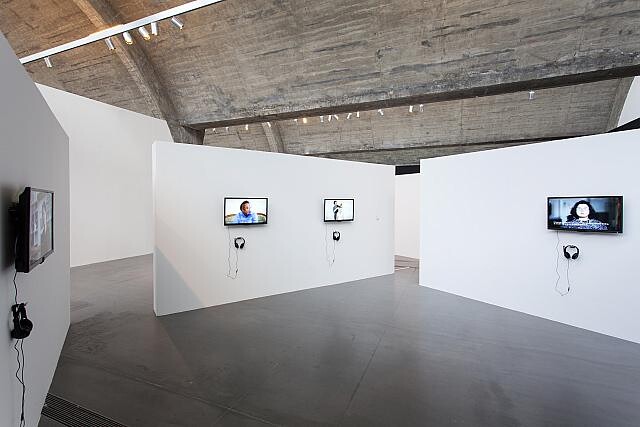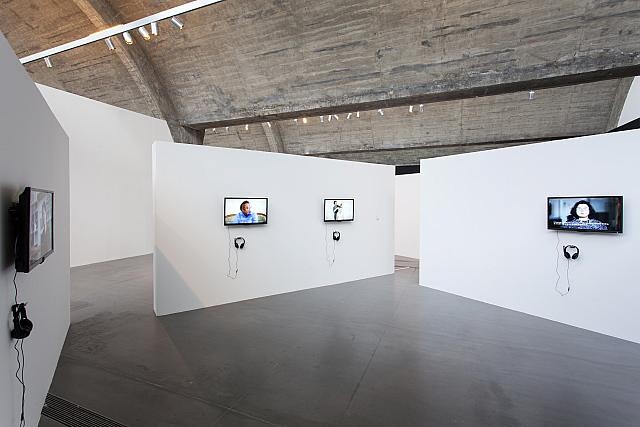December 13, 2014–March 15, 2015
“Unlived by What is Seen” showcases the work of 34 artists, collectives, and organizations, spanning across three galleries (Galleria Continua, Pace Beijing and Tang Contemporary) located in Beijing’s 798 Art district. In contrast to its elusive English version, the show title reads straightforwardly in Chinese: Bu Zai Tu Xiang Zhong Xing Dong, literally meaning “Not Acting Within Images.”
Organized by independent curator Cui Cancan and artist duo Sun Yuan and Peng Yu, this project amounts to a vague attack on the image and visual production, even as it ends up as a vast pool of images, particularly of the moving sort, with a total viewing time of around 80 hours—made up mostly of interviews with artists. Here the image is belittled as the residue of life, although the curators emphasize the non-archival dimension of the exhibition. Writer Eileen Chang refers to the (photographic) image as the empty shells left over when the nuts inside have been consumed. Likewise, here visitors are presented with “nuts”1, Wanxiang (January–June 1944). Translation the author’s own.] like Cai Dongdong, Hu Yinping, and Jinag Bo’s Chang An Street Rally (2014), a video documenting a furtive race along the east-west axis of Beijing, and artist collective First Floor’s Sneak In (2010/2014), photographs produced when they found the key to a random office.
Social practices and practices of the everyday are given pride of place, resulting in the constant appropriation of readymades extracted from situations of social interaction: Zhang Mingxin shows four stalls he bought from street vendors over the course of two years (Natural Health Tea, Jiangnan Leather Factory, Pancakes, Super All-Purpose Adhersive, 2014); Li Bingyuan collects screenshots from his WeChat Moments (2013131-2014927, 2014), a Chinese social media platform not unlike Facebook, from January 31 to September 27, 2014; Huang Yan records the composition of his daily activities, from surfing the internet to clipping his nails, and produces large-scale prints on paper with pie and bar charts documenting the resulting statistics (MY LIFE (2012.11.1—2014.11.3), 2014). Elsewhere, social relations are staged on-site—something like relational aesthetics—in works like Wei Bingqiang’s invitation for the audience to take with them stones he collected while leaving others behind (Gifts for Friends, 2010–2014). The immediacy of experience is accentuated by the corporeal or emotional tension ignited by tokens of love, delayed primal scenes, or physical pain, as with Hu Yinping’s 01092014 (2014), in which the artist documented her parents’ intercourse (here, a video with her verbal description of this work is exhibited). Zhao Zhao’s Slap and Secret Love, Leather Shoe and Family (2014), includes a photograph of people slapping him, and Hua Weihua’s video of 23 deliberate car crashes (Striking Trees, 2014) into 22 trees portray equally intense situations.
Claiming to show art “no longer geared toward production of images and visual objects,”2 the exhibition stages a dichotomy between image and action, trying to respond to an urgent appeal to rethink the image and its modus operandi in our current time. The direction is timely and “correct,” yet the contemplation goes little beyond clichéd critique, in which the image is considered a haunting reminder of “life” outside the gallery walls. Works like Slap and Secret Love, Leather Shoe and Family and Striking Trees stage images as the death mask of a “living” event; in its lack of deeper interpretation of its very subject matter, the exhibition fails to decode the mysterious contradictions inherent in using a vast amount of images to advocate for a resistance to the visual. With much of the exhibition devoted to the social and the living, the image remains a fuzzy silhouette gloomily depicted by negative space. The selection of artworks lacks examples of narratives that are built between the poles of this dualism. This leaves the image almost empty, as an airy idol and an ill-defined target. Many of the works stand out by themselves, like Xie Nanxing’s series “Triangle Relations Gradually Changing” (2013), a canvas painted through another canvas mounted on top of it. Nanxing’s method breaks the one-way street between the movements of a painter’s body and the painting’s surface, releasing the visual traces of his own hands, while working outside the conventional relationship between the surface and the frame. However, these contemplations are flattened under the airy dualism of life versus image.
The curators mark 2008 as the year of genesis for a form of artistic practice that turned its back on image production and instead embraced the social aspect of art. Beijing’s Olympic year was, and is, undoubtedly crucial to Chinese people—the art world included—in their self-regard as a world power, not to mention as an event that raised the curtain on stricter governmental censorship and biopolitical control. But 2008 also marks the rise of Chinese social media, filling a discursive void with content ignored by China’s mainstream news outlets—that of every person with a camera phone. This change in media culture, where image and event happen simultaneously, means that the image is no longer a referent to an external event—it is an empirical event in itself. It appears when an event externalizes, assembles, and resembles itself to be present.3 Premised on the impotency of the contemporary image, the exhibition rather paradoxically reiterates how our society is directed towards visual production as the public sphere is replaced by public images in popular media.
Eileen Chang, “Lian Huan Tao” [Chained Links
Excerpted from the curatorial statement of the exhibition. Jean Luc Nancy, Ground of the Image, trans. Jeff Fort, (New York: Fordham University Press, 2005), 24.
Jean Luc Nancy, Ground of the Image, trans. Jeff Fort, (New York: Fordham University Press, 2005), 39.












